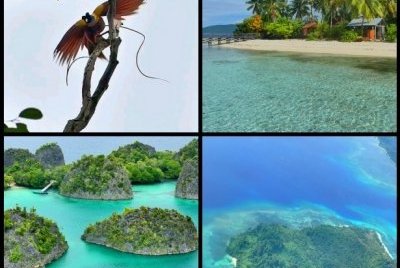Indonesia
Raja Ampat Islands
Site Info
Official Information
- Full Name
- Raja Ampat Islands (ID: 2003)
- Country
- Indonesia
- Status
-
On tentative list 2005
Site history
History of Raja Ampat Islands
- 2005: Added to Tentative List
- Added to tentative list
- Type
- Natural
- Criteria
Links
- UNESCO
- whc.unesco.org
All Links
UNESCO.org
- whc.unesco.org — whc.unesco.org
Community Information
- Community Category
- Natural landscape: Marine and Coastal
Travel Information
Recent Connections
News
No news.
Community Reviews
Show full reviews
Highly recommended even for non-divers. Obviously the main draw is diving and even snorkeling is popular at the resorts but you'll be missing a lot of the area just looking at the lush-green karst and trying your luck to see a special bird, or any bird really. The obvious choice of coming here is a liveaboard but resorts have their own transportation so staying on one and doing day trips is a good option, and you can even get a public ferry of sorts if you want to go budget (not recommended). So I went with the liveaboards for ~2 weeks and the price was higher than most places around the world but I wouldn't want to compare this to a budget safari on the red sea - you get a lot more out here and the distances are quite far so fuel costs are something to keep in mind. All tours start in Sorong which has decent flight connections but I would recommend not having to stay in a hotel here because it's not a lovely town or anything, thus try to arrive with a morning flight and go directly to the boat. The tour I chose was specific because it started going to Misool in the south, prettier for underwater but troublesome to arrange diving because local "owners" will restrict each site to one boat per hour. In Central, the area that is in the center of the islands, you don't have this problem and you get more …
Keep reading 0 comments
I visited these remote islands in West Papua, Indonesia in September 2018. To get there I caught a series of internal flights (Garuda Indonesia is the most reliable overall) via Jakarta and Mekassar, Sulawesi until we landed in Sorong Airport. From there we took an airport taxi to the Sorong ferry harbour where we bought our 'VIP ferry tickets' (important if you have big luggages and want comfortable seats and air condition) to Waisai island.
I must say that considering that there are no international flights to West Papua and limited infrastructure, the Raja Ampat Marine Park management and entrance permit system is top notch. Other parks and indeed WHS such as Komodo NP should really emulate Raja Ampat's system which is really simple and practical. Upon disembarking from the ferry at Waisai island and before heading to the different small boats which take you to different home stays or smaller islands, there is a make shift booth welcoming visitors where you currently pay 1 million rupiah and a laminated credit card format permit with your name is printed on the spot and is valid for 1 year. No more snorkelling fees, ranger fees, conservation fees and hassles as per Komodo NP for example.
We had booked online at a home stay island (top right photo) with rudimental over-the-water rooms and already the choppy currents to get there were a premonition of what was yet to come in the coming days. In all we spent 4 nights there …
Keep reading 0 comments
The islands of Raja Ampat are right in the middle of the center of diversity of coral reefs and reef fish in the Indo-Pacific; it is hard to come up with a better reason than that to include anything in the list of World Heritage. I visited on board a ship dedicated to scuba diving, and boy was it ever worth it. The reefs are almost pristine, mostly because there are no large cities nearby and so there isn't much runoff or (many) fishermen. Huge schools of fish, both small and colourful and also very large (snappers the size of Volkswagens!), sea snakes, dugongs, sea turtles. Oh, an on land there are birds of paradise, too. An amazing place.
Keep reading 0 comments
